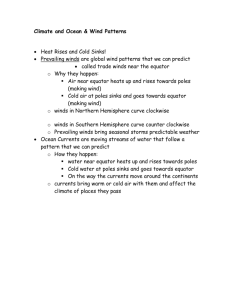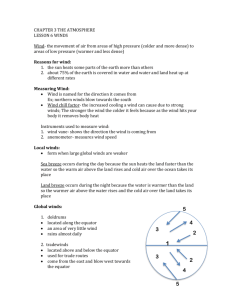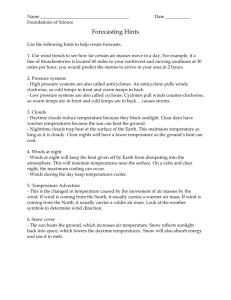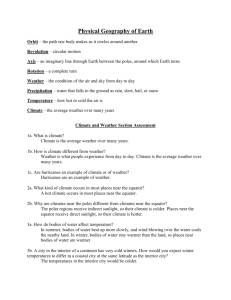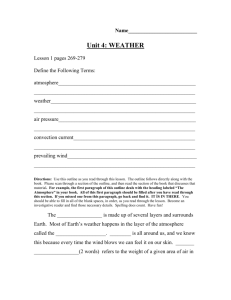File
advertisement
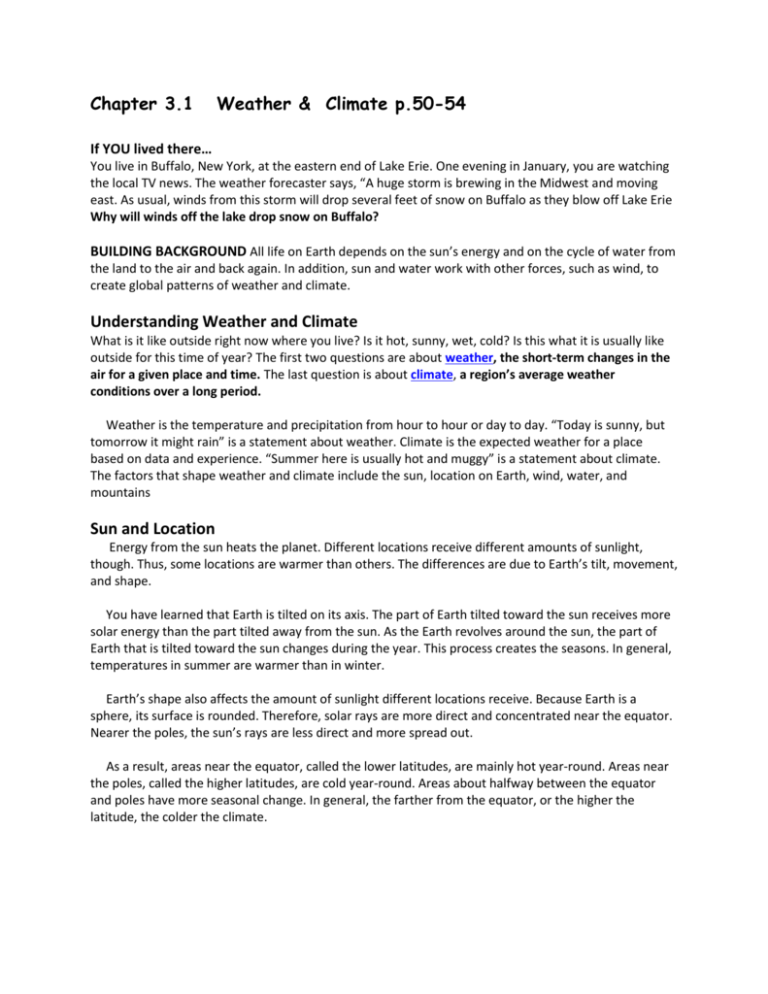
Chapter 3.1 Weather & Climate p.50-54 If YOU lived there… You live in Buffalo, New York, at the eastern end of Lake Erie. One evening in January, you are watching the local TV news. The weather forecaster says, “A huge storm is brewing in the Midwest and moving east. As usual, winds from this storm will drop several feet of snow on Buffalo as they blow off Lake Erie Why will winds off the lake drop snow on Buffalo? BUILDING BACKGROUND All life on Earth depends on the sun’s energy and on the cycle of water from the land to the air and back again. In addition, sun and water work with other forces, such as wind, to create global patterns of weather and climate. Understanding Weather and Climate What is it like outside right now where you live? Is it hot, sunny, wet, cold? Is this what it is usually like outside for this time of year? The first two questions are about weather, the short-term changes in the air for a given place and time. The last question is about climate, a region’s average weather conditions over a long period. Weather is the temperature and precipitation from hour to hour or day to day. “Today is sunny, but tomorrow it might rain” is a statement about weather. Climate is the expected weather for a place based on data and experience. “Summer here is usually hot and muggy” is a statement about climate. The factors that shape weather and climate include the sun, location on Earth, wind, water, and mountains Sun and Location Energy from the sun heats the planet. Different locations receive different amounts of sunlight, though. Thus, some locations are warmer than others. The differences are due to Earth’s tilt, movement, and shape. You have learned that Earth is tilted on its axis. The part of Earth tilted toward the sun receives more solar energy than the part tilted away from the sun. As the Earth revolves around the sun, the part of Earth that is tilted toward the sun changes during the year. This process creates the seasons. In general, temperatures in summer are warmer than in winter. Earth’s shape also affects the amount of sunlight different locations receive. Because Earth is a sphere, its surface is rounded. Therefore, solar rays are more direct and concentrated near the equator. Nearer the poles, the sun’s rays are less direct and more spread out. As a result, areas near the equator, called the lower latitudes, are mainly hot year-round. Areas near the poles, called the higher latitudes, are cold year-round. Areas about halfway between the equator and poles have more seasonal change. In general, the farther from the equator, or the higher the latitude, the colder the climate. Wind and Water Heat from the sun moves across Earth’s surface. The reason is that air and water warmed by the sun are constantly on the move. You might have seen a gust of wind or a stream of water carrying dust or dirt. In a similar way, wind and water carry heat from place to place. As a result, they make different areas of Earth warmer or cooler. On a global scale, this rising, sinking, and flowing of air creates Earth’s prevailing wind patterns. At the equator, hot air rises and flows toward the poles. At the poles, cold air sinks and flows toward the equator. Meanwhile, Earth is rotating. Earth’s rotation causes prevailing winds to curve east or west rather than flowing directly north or south. Depending on their source, prevailing winds make a region warmer or colder. In addition, the source of the winds can make a region drier or wetter. Winds that form from warm air or pass over lots of water often carry moisture. In contrast, winds that form from cold air or pass over lots of land often are dry. Ocean Currents Like wind, ocean currents—large streams of surface seawater—move heat around Earth. Winds drive these currents. The map above shows how Earth’s ocean currents carry warm or cool water to different areas. The water’s temperature affects air temperature near it. Warm currents raise temperatures; cold currents lower them. The Gulf Stream is a warm current that flows north along the U.S. East Coast. It then flows east across the Atlantic to become the North Atlantic Drift. As the warm current flows along northwestern Europe, it heats the air. Westerlies blow the warmed air across Europe. This process makes Europe warmer than it otherwise would be. Large Bodies of Water Large bodies of water, such as an ocean or sea, also affect climate. Water heats and cools more slowly than land does. For this reason, large bodies of water make the temperature of the land nearby milder. Thus, coastal areas, such as the California coast, usually do not have as wide temperature ranges as inland areas. As an example, the state of Michigan is largely surrounded by the Great Lakes. The lakes make temperatures in the state milder than other places as far north. Wind, Water, and Storms If you watch weather reports, you will hear about storms moving across the United States. Tracking storms is important to us because the United States has so many of them. As you will see, some areas of the world have more storms than others do. Most storms occur when two air masses collide. An air mass is a large body of air. The place where two air masses of different temperatures or moisture content meet is a front. Air masses frequently collide in regions like the United States, where the westerlies meet the polar easterlies. Fronts can produce rain or snow as well as severe weather such as thunderstorms and icy blizzards. Thunderstorms produce rain, lightning, and thunder. In the United States, they are most common in spring and summer. Blizzards produce strong winds and large amounts of snow and are most common during winter. Thunderstorms and blizzards can also produce tornadoes, another type of severe storm. A tornado is a small, rapidly twisting funnel of air that touches the ground. Tornadoes usually affect a limited area and last only a few minutes. However, they can be highly destructive, uprooting trees and tossing large vehicles through the air. Tornadoes can be extremely deadly as well. In 1925 a tornado that crossed Missouri, Illinois, and Indiana left 695 people dead. It is the deadliest U.S. tornado on record. The largest and most destructive storms, however, are hurricanes. These large, rotating storms form over tropical waters in the Atlantic Ocean, usually from late summer to fall. Did you know that hurricanes and typhoons are the same? Typhoons are just hurricanes that form in the Pacific Ocean. Hurricanes produce drenching rain and strong winds that can reach speeds of 155 miles per hour (250 kph) or more. This is more than twice as fast as most people drive on highways. In addition, hurricanes form tall walls of water called storm surges. When a storm surge smashes into land, it can wipe out an entire coastal area. Mountains Mountains can influence an area’s climate by affecting both temperature and precipitation. Many high mountains are located in warm areas yet have snow at the top all year. How can this be? The reason is that temperature decreases with elevation—the height on Earth’s surface above sea level. Mountains also create wet and dry areas. Look at the diagram at left. A mountain forces air blowing against it to rise. As it rises, the air cools and precipitation falls as rain or snow. Thus, the side of the mountain facing the wind is often green and lush. However, little moisture remains for the other side. This effect creates a rain shadow, a dry area on the mountainside facing away from the direction of the wind. Name __________________________________ Date _______________________ Hour _____ 25 WORD SUMMARY - 3.1 Weather & Climate p. 50-54
